
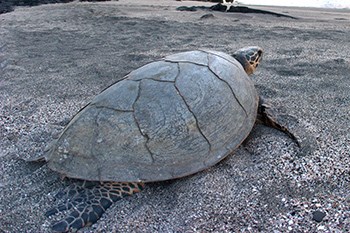
Honuʻea (Hawksbill Turtles)Called honuʻea or ʻea by Native Hawaiians, the hawksbill (Eretmochelys imbricata), is an endangered sea turtle that lives in the waters of the islands. It can be most easily differentiated from the more common green sea turtle by its sharper, more pointed beak. The plates on hawksbill shells also overlap, like shingles. Hawksbills are generally about half the size of the more common green sea turtles, averaging 75- 150 pounds (34- 68 kg). They are known to nest on nine beaches on Hawaiʻi (including in Hawaiʻi Volcanoes National Park), on one beach on Maui and at an unknown number of locations on Molokaʻi. Loss of nesting habitat, predation and poaching (their shells make attractive jewelry, illegally sold worldwide as tortoiseshell) have reduced turtle populations to critically low levels.Late May signals the start of nesting season, which extends to December. A female will wait until night to crawl ashore in search of a suitable nesting site on the beach, ideally near vegetation. She will use her strong flippers to dig a flask-shaped cavity, into which she will deposit an average of 178 eggs. After covering the eggs with sand, she will return to the sea exhausted, leaving the eggs to incubate during the next two months. Working as a team, the tiny hatchlings scrape the sand off the roof of the cavity and pack it on the floor. In doing so, they raise their nest toward the surface of the beach. When they are about an inch from the surface, they test the sand. If it is cool, an indication of darkness, they emerge from the nest as a group and scramble to the water. Any artificial light source may attract the hatchlings and cause them to head away from the water, get stranded and die. As few as one in 1,000 honu'ea hatchlings survive to adulthood. 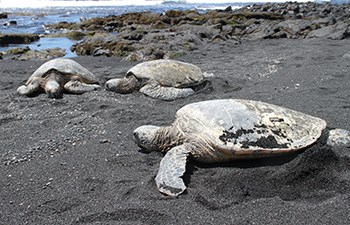
Honu (Green Sea Turtles)Though a comparatively common sight along Hawaiian beaches, green sea turtles are listed as a federally threatened species. These turtles can average between 150- 400 pounds in weight (68- 181 kg). Unlike the rarer hawksbill turtles, green sea turtles have a rounded head. The plates on its shell grow together like tiles and do not overlap. An estimated 200,000 adult female green turtles exist today, down from a one time population of tens of millions. When spotted, they are often feeding on limu and algae that grows on coral and near-shore rocks, or basking in the sun at the water's edge. 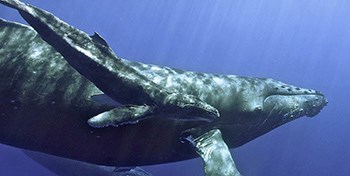
Koholā (Humpback Whales)Like some species of birds that winter in the islands, humpback whales (Koholā in Hawaiian) make long seasonal migrations to Hawaiʻi. Beginning in November, whales arrive in the Hawaiian Islands from the North Pacific and will spend the winter calving and breeding in near-shore waters less than 600 feet (182 m) deep. The coastline of the park is not a popular place for them to dwell, but they can occasionally be spotted from the coast of the park when they are travelling to more popular breeding grounds, particularly near Maui and Molokaʻi. It is possible that up to half of the entire Pacific Ocean's humpback whale population may concentrate in the Hawaiian Islands during the winter months. From March to May, the whales will begin the reverse trip, once again heading north. These mammoth creatures can grow to be 50 feet long (15 m) and weigh up to 40 tons (36,000 kg).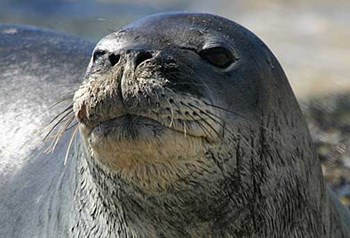
‘Īlio Holo I Ka Uaua (Hawaiian Monk Seal)The ‘Īlio holo i ka uaua, or the Hawaiian monk seal, is one of the most endangered seal species in the world. According to NOAA, the population is estimated to be around 1,400 seals—about 1,100 seals in the Northwestern Hawaiian Islands and 300 seals in the main Hawaiian Islands. Hawaiian monk seals are mostly solitary and don't live in colonies like sea lions or other seals. But they do sometimes lie near each other—usually not close enough to make physical contact—in small groups. They usually sleep on beaches, when they are most often seen. When fully grown, they can reach lengths of up to seven feet and weights of 600 pounds.They are very rarely seen in Hawaiʻi Volcanoes National Park, but are more frequently spotted elsewhere on Hawaiʻi Island. If you encounter one slumbering on the beach, be respectful and give it space. Do not approach. 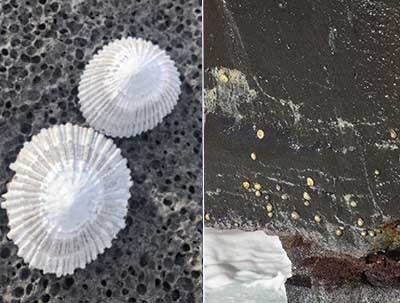
ʻOpihiThese small limpets can be seen clinging to rocks and and even sheer vertifcal cliffs on the coastline. Underneath their shell, ʻopihi have a single large suction-cup-like foot that they use to both move around and to cling to the rocks they call home, feeding on algae that gathers there. Two of the three species that are endemic to Hawaiʻi can be found within Hawaiʻi Volcanoes National Park. ʻĀlinalina (yellow-footed ʻopihi) tend to reside below the tide line. The other species, makaiauli (black-footed ʻopihi), are most often found higher, where the crashing of waves is not as constant.They have been collected by Hawaiians for food throughout history, and in modern times are considered a delicacy. Given the occasionally precarious location of ʻopihi, harvesting the creatures can be a notoriously dangerous affair. The creatures do not have "eyes" but are sensitive to light and are likely to clamp down tightly to the rocks if they happen to fall in shadow. An ʻopihi that is securely fastened to the rock may be nearly impossible to remove, even by the most determined hunter. 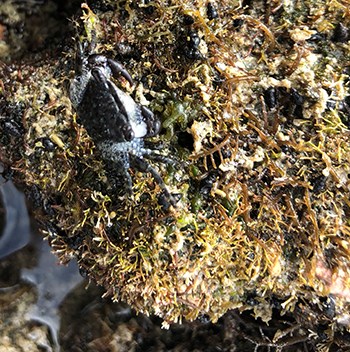
ʻAʻama (Rock Crab)Frequently seen along the rocky shores of Hawaiʻi, these dark-colored crabs may be nearly invisible against the rock when stationary. But when a group begins to scurry, it may seem like the shoreline itself is alive. Hawaiians often eat ʻaʻama raw or use them as fishing bait. The small creatures, typically no larger than three inches wide, are excellently designed for life in the rough-and-tumble surf. Their low, mostly flat bodies allow them to cling to the constantly-battered rocks or hide in the tiniest of crevices.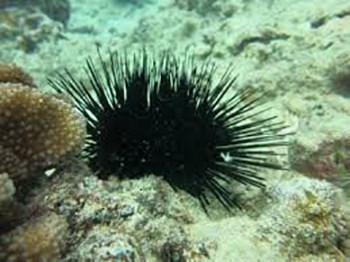
Wana (Sea Urchins)Several species of the sharp-spined sea urchins are collectively referred to in Hawaiʻi as wana. The spines of some wana can reach up to six inches and length. These spines are brittle and may break off in human skin, causing severe irritation. The painful sting can be best treated by soaking in hot water to help deactivate the protein toxins, or by soaking in vinegar to help dissolve the spines themselves.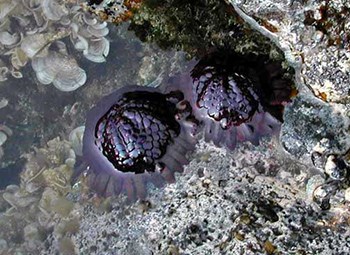
Haʻukeʻuke (Helmet Urchins)Rather than the sharp spines that many sea urchins have, haʻukeʻuke have developed plated domes that help them stand the battering forces of the surf. Look for these tough purple creatures clinging to the cliffs along the Puna coast. |
Last updated: February 18, 2021
